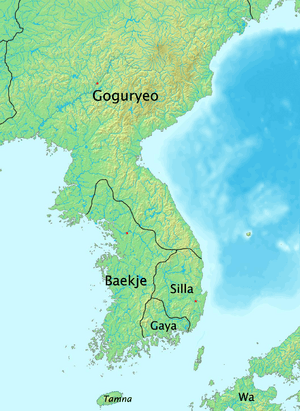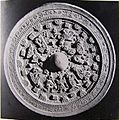Baekje facts for kids
Baekje was an ancient kingdom located on the Korean Peninsula. It existed for a very long time, from 18 BCE (Before Common Era) until 660 CE (Common Era). Baekje was also known as Nam Buyeo.
According to an old Korean history book called the Samguk Sagi, Baekje was started by a person named Onjo. He founded the kingdom in a place called Wirye-sung. This area is now part of Seoul, near the Han River. Baekje was one of the Three Kingdoms of Korea, along with Goguryeo and Silla. These three kingdoms often fought each other to gain more land. They also sometimes made alliances to fight against a common enemy.
The Rise of Baekje
In the 4th century, Baekje became very powerful. It took control of almost all the southern parts of the Korean Peninsula. The kingdom grew and became rich by accepting Buddhism as a religion. They also made important changes to their government system.
Baekje had a great location for trade. Its natural environment made it easy to trade with powerful countries like China and Japan. Baekje shared its advanced culture with Japan, especially during the Kufun period. They taught the Japanese about new ways to make pottery and introduced them to Buddhism.
Challenges and Decline
However, in the 5th century, Baekje faced a big challenge. It was defeated by the kingdom of Goguryeo. Baekje lost its capital city and had to move it. The new capital was established in a place called Ungjin.
Later, in the 6th century, a king named Seong decided to move the capital again. He moved it to Sabi. King Seong hoped this move would help Baekje become as strong and glorious as it once was. But despite these efforts, Baekje was eventually defeated by the kingdom of Silla in 660 CE.
Even after Baekje was destroyed, some of its descendants tried to bring the kingdom back. However, these attempts were not successful.
Images for kids
-
Tang Dynasty envoys from Baekje
-
Ambassador of Baekje at the Chinese court of Emperor Yuan of Liang in his capital Jingzhou in 516–520 CE, with explanatory text. Portraits of Periodical Offering of Liang, 11th century Song copy.
-
Guze Kannon is a Buddhist statue made in the image of King Seong in the Korean style. The statue, originally from Baekje, is kept in the Dream Hall at the Japanese temple Hōryū-ji.
See also
 In Spanish: Baekje para niños
In Spanish: Baekje para niños








